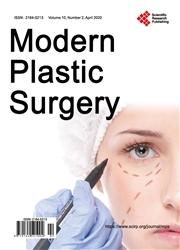Effects of Cold Atmospheric Pressure Plasma on Accelerating Acute Wound Healing: A Comparative Study among 4 Different Treatment Groups
引用次数: 7
Abstract
Cold atmospheric pressure plasma (CAP) has been expected to be effective for wound healing among plasma medicines and has been attracting attention. The aim of this retrospective clinical study was to evaluate and compare the effects of CAP on acute wounds created by a fractional CO2 (FXCO2) laser on four treatment groups. Methods: This study was conducted between September 2017 and November 2018. Radiated surface wounds were created using a FXCO2 laser on four identically-sized regions on the medial side of the left forearm of 12 healthy volunteer subjects, for a total of 48 treatment regions. Each region was then randomly assigned to one of four groups: 1) no treatment (control group), 2) irradiated CAP for 60 seconds (plasma group), 3) topical application of ointment containing betamethasone valerate (steroid group), or 4) two to three sprays of basic fibroblast growth factor (bFGF group). The primary outcome of the skin was the change in absolute values of lightness index (L*), redness index (a*I) of L*a*b color space, arithmetical mean roughness (Ra), and mean melanin concentration. The secondary outcome was the clinical condition of the wounds, including inflammation, crust formation, and hyper/hypo-pigmentation on the recovering skin surface relative to the surrounding intact skin. Each item was evaluated at post-treatment 0, 1, 3, 7, 14, 28 days and 1 year. Results: Although no significant difference was observed among all groups, the CAP group exhibited more rapid recovery regarding a*I and Ra. No side-effects were observed in the CAP group. Conclusion: CAP is considered to accelerate healing of irradiated wounds via anti-inflammatory activity. Our study confirmed the effectiveness and safety of CAP which is devoid of side-effects of conventional therapies, and may aid in future development of medical plasma therapies.低温常压血浆加速急性创面愈合4个不同治疗组的比较研究
低温大气压等离子体(CAP)在等离子体药物中被认为对伤口愈合有效,并引起了人们的关注。这项回顾性临床研究的目的是评估和比较CAP对四个治疗组的分数CO2(FXCO2)激光造成的急性伤口的影响。方法:本研究于2017年9月至2018年11月进行。使用FXCO2激光在12名健康志愿者受试者左前臂内侧的四个相同大小的区域上创建辐射表面伤口,总共48个治疗区域。然后将每个区域随机分配到四组中的一组:1)不治疗(对照组),2)照射CAP 60秒(血浆组),3)局部施用含有戊酸倍他米松的软膏(类固醇组),或4)两到三次喷洒碱性成纤维细胞生长因子(bFGF组)。皮肤的主要结果是L*a*b颜色空间的亮度指数(L*)、发红指数(a*I)、算术平均粗糙度(Ra)和平均黑色素浓度的绝对值的变化。次要结果是伤口的临床状况,包括炎症、结皮形成和恢复中的皮肤表面相对于周围完整皮肤的高/低色素沉着。在治疗后0、1、3、7、14、28天和1年对每个项目进行评估。结果:尽管各组之间没有观察到显著差异,但CAP组在a*I和Ra方面表现出更快的恢复。CAP组未观察到副作用。结论:CAP可通过抗炎作用促进辐照创面的愈合。我们的研究证实了CAP的有效性和安全性,它没有传统疗法的副作用,并可能有助于未来医用血浆疗法的发展。
本文章由计算机程序翻译,如有差异,请以英文原文为准。
求助全文
约1分钟内获得全文
求助全文

 求助内容:
求助内容: 应助结果提醒方式:
应助结果提醒方式:


